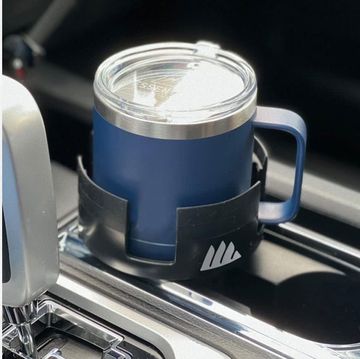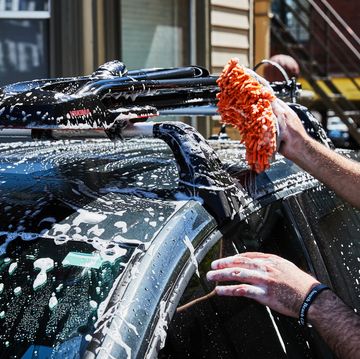An oncoming car suddenly splashes a huge wave of muddy water at you. Panicked, you manage to toggle the windshield wipers on, clearing the sluicing muddy water away. But as the water dries, your vision is clouded by the remaining muddy film. Desperately searching for a small spot of vision, you attempt two things--look for a safe way out of traffic, and yank on the toggle for the windshield washers. But the traffic isn't cooperating, nor are the washers. A few drops of liquid drizzle onto the cowl, but not enough to do more than aggravate the problem. As the windshield continues to smear and become more opaque, the traffic does too.
First Things First
This should be obvious. Is there washer fluid in the reservoir? In temperatures above freezing, plain water is generally adequate. If there's a chance you'll see subfreezing temperatures, you'll need to use the traditional blue fluid, which is a mixture of water, alcohol to depress the freezing point, and detergents. The blue color is just dye.
Cleanliness Is Next To Godliness
Your windshield washers are a valuable safety system on your car or truck. And like other automotive systems, this one can require a little maintenance.
Does fluid pump languidly out of the nozzle? Or squirt out healthily right over the top of the vehicle, washing the windshield of the car behind you in the drive-through lane? Try cleaning and aiming the nozzles. Most washer nozzles can be aimed by simply sticking a straight pin in them and repointing them. This procedure may also clean out any accumulated junk. If that doesn't help, you may have debris elsewhere in the line or in the pump. Or, there may be a leak. Starting at the nozzle, follow the hose back to the pump. Pull the hose off at the pump outlet and give the washers a good squirt. If there's plenty of volume, try cleaning the lines with compressed air or water. Pull the hose off at the nozzle, and remove the nozzle from the hood or cowl. You may need to squeeze a tab with pliers or push the nozzle back against a spring to remove it. Clean the nozzle with running water or compressed air. If you have wet-arm wipers with the nozzles mounted on the wiper arms, you can pull the arms off. If there's a check valve, clean it as well, remembering that fluid should flow in only one direction. Clean the hose too. Now might be a good time to replace the hoses if your car is 10 or more years old.
Motor
Is the flow from the pump motor insufficient? Try cleaning the motor inlet, which may involve removing the tank from the fender. It's generally held in place with three or four fasteners. If other underhood items make removal difficult, leave the tank in place and remove the pump. Disconnect any electrical connections to the tank. Most pumps are held in place with a simple friction fit into a c-section grommet in the tank wall. A little wiggling generally will be enough to remove it. Remember that any liquid in the tank will drain out, so don't wear new white sneakers unless you want them to be dyed blue. If there's any debris in the tank, flush it thoroughly and vow to clean your funnel before refilling. Be sure the cap fits snugly and is in place to prevent road grime from creeping into the tank.
With the pump out and on your bench, gently clean any debris out of the inlet. Don't just blow backward with compressed air--you may damage a check valve at the pump outlet. Try cleaning the inlet with running water. Don't use solvents. Reinstall the pump and refill.
Aiming the washer nozzles is often as simple as inserting a needle or pin. This may help to clear debris as well.
Some nozzles can be removed by sliding them fore or aft in their mount (above), while others may require squeezing their mounting tabs with pliers to loosen them (below).
Igor! The Kites!
But what if the pump isn't running at all? Then you may have an electrical problem. Start by checking the fuse--which is probably shared with the wiper motor. If the wipers wipe, the fuse is okay. Check the owner's manual or the cover of the fuse box for specifics.
If the fuse is okay, use your voltmeter or test light to see if current is getting to the motor by probing at the pump connectors. If you see 12 volts there, you have a bad pump motor. Try whacking the pump with a screwdriver handle while it's powered--you may be able to tease it into life long enough to find a proper replacement. Universal replacement pumps can be had, but some vehicles need the pricier OEM parts.
If you have a good fuse in the circuit but no voltage at the pump connector, you have bad wiring or a bad switch. Hope for chafed wiring, because getting into most modern steering columns to replace a bad switch is a job for a professional who's trained to properly deactivate the airbag while he's taking apart the switchgear.
On Strike
Does the washer work fine most of the time, but quit altogether or drizzle on freezing, sleety days? You may have a bad check valve. The check valve, which may be built into the pump or installed in the hose as a separate part, is there to prevent low-freezing-point washer fluid from draining back into the reservoir. If the valve is leaky, retreating washer fluid can suck rain or snowmelt back into the nozzle--where it freezes and plugs up the works. The valve also keeps the hose primed so you get an instantaneous shot of fluid when you toggle the washer switch. If you have a bad check valve in the pump, you may be able to install an inline valve in the hose.
Many vehicles have a low-fluid indicator light. It can fail in one of two ways: Either it stays on even when the reservoir is full, or it never comes on, even when the pump is running dry. No light at all may mean an open electrical circuit, which you'll have to chase with a voltmeter or test light. Or, no light may be caused by the same thing that causes a constantly on light--a stuck sender float. Either way, it should be easy to trace.
A stuck or leaky check valve can cause freeze-up on cold, sleety days.
If you have rear-window washers, you probably have a second pump to supply them from the reservoir--or a second reservoir in the rear.













